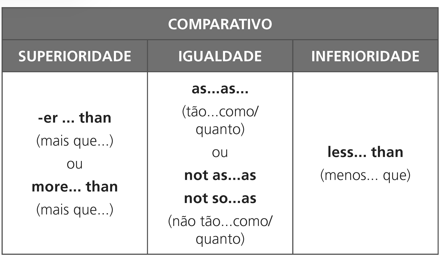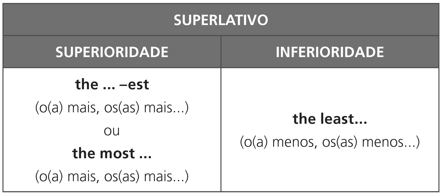
Os comparativos de superioridade com -er são usados com adjetivos e advérbios de até duas sílabas.
Exemplos:
Americans are taller than Indians.
Today is colder than yesterday.
Os comparativos de superioridade formados com more … than são usados com adjetivos e advérbios com mais de duas sílabas.
Exemplos:
Joana is more beautiful than her neighbor Julia.
João is more intelligent than Roberto.
Os comparativos de igualdade são usados com qualquer adjetivo ou advérbio, independente do número de sílabas.
Exemplos:
Australia is as hot as Brazil.
Pedro is not as tall as Felipe.
We cannot run as fast as horses.
Martha is as beautiful as Daniela.
Os comparativos de inferioridade são usados com qualquer adjetivo ou advérbio, independente do número de sílabas.
Exemplos:
Bruna is less beautiful than Carla.
This house is less valuable than that one.
Bruno is less tall than Carlos.

Os superlativos com the … –est são usados com adjetivos e advérbios de até duas sílabas.
Exemplos:
That city is the coldest in the country.
My garden is the liveliest in town.
Os superlativos com the most … são usados com adjetivos e advérbios com mais de duas sílabas.
Exemplos:
Pablo is the most foolish person of the offce.
This exercise is the most difficult of the book.
Os superlativos de inferioridade são usados com qualquer adjetivo ou advérbio, independente do número de sílabas.
Exemplos:
Rita is the least tall of all the girls I know.
Lisa is the least beautiful woman of the course.
Os adjetivos abaixo, que terminam em -y e –ly, podem formar o comparativo e superlativo de superioridade da seguinte forma.
Exemplos:
heavy / heavier than / the heaviest
handy / handier than / the handiest
lonely / lonelier than / the loneliest
happy / happier than / the happiest
lively / livelier than / the liveliest
funny / funnier than / the funniest
Os adjetivos e advérbios abaixo, embora tenham duas sílabas, podem ser usados com o comparativo more … than e superlativo com the most. São exceções à regra de até duas sílabas.
Exemplos:
afraid / more afraid than / the most afraid
frequent / more frequent than / the most frequent
certain / more certain / the most certain
correct / more correct / the most correct
exact / more exact / the most exact
often / more often / the most often
seldom / more seldom / the most seldom
modern / more modern / the most modern
normal / more normal / the most normal
recent / more recent / the most recent
Os adjetivos quiet, simple, clever, common, gentle, narrow, pleasant e polite aceitam as duas formas comparativas de superioridade.
Exemplos:
clever / cleverer than / more clever than / the cleverest / the most clever
narrow / narrower than / more narrow than / the narrowest / the most narrow
shallow / shallower than / more shallow than / the shallowest / the most shallow
Alguns adjetivos e advérbios apresentam formas irregulares para o comparativo e para o superlativo de superioridade.
Exemplos:
good / well / better than / the best
bad / badly / worse than / the worst
little / less than / the least
many / much / more than / the most
far / farther than / the farthest (para indicar distância)
further than / the furthest (para indicar tempo)
old / older than / the oldest (para pessoas, animais, coisas e eventos)
elder / the eldest (somente para pessoas, e da mesma família) elder nunca é seguido de than. É usado em estruturas como “my elder brother …”
Utilizamos as estruturas comparativas de superioridade referindo-se a quantidades ou a um extremo na quantidade (muitas vezes essa regra vale para qualidades):
Exemplos:
She spent less on clothes than Anna did.
The Hotel Copacabana has the most rooms.
The most gracious was Bahia.
A estrutura de gradual increase, ou crescimento gradual (= cada vez mais, mais e mais), é formada através de be getting/ becoming + uma forma comparativa de superioridade (com -er ou more) repetida ou não.
Exemplos:
Those teachers are getting / becoming fatter.
Those students are getting / becoming fatter and fatter.
Those policemen are getting / becoming more and more fat.
Those girls are getting / becoming more beautiful.
Those women are getting / becoming more and more beautiful.
A estrutura de “parallel” increase, ou crescimento em paralelo (= quanto mais…, mais/menos… / quanto menos…, mais/menos…), é formada por the + comparativo de superioridade (com -er ou more) e … the + comparativo de superioridade (com -er ou more).
Exemplos:
The hotter the weather is, the better for all of us.
The more careful you are with your child, the less worried you’ll be.
The better the computer, the more expensive it is.
Adjetivos com duas consoantes e apenas uma vogal entre essas consoantes dobram a última consoante.
Exemplos:
sad / sadder / the saddest
thin / thinner / the thinnest
fat / fatter / the fattest




